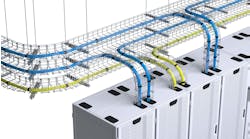3 Strategic Solutions Will Safeguard Next-Generation Data Center Operations
John Hevey, Vice President, Corporate Technical Service at BCS Data Center Operations, explores a group of strategic solutions designed to “safeguard” future data center operations for today’s companies navigating through the current pandemic.
John Hevey, Vice President, Corporate Technical Service at BCS Data Center Operations
In a COVID-19 world, most companies in America are constantly challenged to rethink their business models and operate in new ways. A search for normalcy may be avoiding the realities of the situation. The “next normal” will be much different from anything we have seen or experienced.
Mission-critical infrastructure is not immune to this reality. Uptime Institute’s 2020 global data center survey highlights factors showing the urgency of rethinking data center operations and looking at how and who is operating and protecting your critical infrastructure. Chief factors include:
- 78% of survey respondents cite having a power outage in the past 12 months. Of that group, 75% stated the resulting downtime was within their power to have prevented.
- Hardware refresh cycles are getting longer, putting increased pressure on asset management, maintenance methods and staff capabilities.
- Critical facility management of resiliency, business continuity and downtime varies widely, pointing to the need for rapid adoption of industry best practices.
So, what is a data center owner to do? BCS recommends three strategies that create a framework for critical facility operations in uncertain times.
Strategy 1: Monitor – Develop and execute systems and methods to provide active, real-time monitoring of critical infrastructure.
Strategy 2: Measure – Establish a business intelligence ecosystem that measures key performance indicators that drive efficiency, resiliency and overall performance of your critical infrastructure.
Strategy 3: Manage – Rethink your current management program to move beyond the traditional preventative mindset, to one that is more predictive.
Following are descriptions of these strategic solutions along with practical approaches owners can take to mitigate risk, decrease total cost of ownership (TCO) and chart a positive course for their critical facilities and infrastructure.
Strategy 1: Monitor Infrastructure Using Real-Time, Eyes-On-Glass Capability
Effective monitoring starts with situational awareness of the diverse systems, physical infrastructure and human resources that align with operating and protecting your data centers. The best monitoring solution combines trusted people, proven processes and leading technology into one integrated approach, creating both top-down visibility and bottom-up real-time awareness.
Best industry practices for effective monitoring use purpose-built, business intelligence systems, combined with deploying tactical, eyes-on-glass, remote monitoring capability for maximum visibility and 24/7, real-time operational incident management.
Too often, what is intended as a lights-out critical facility, does not have the advanced telemetry or a remote visibility in place to protect it against loss of customer service, loss of credibility and loss of reputation. Here’s a case in point:
The Company: A large telecommunications provider serving a Top 5 metropolitan city.
The Incident: A transformer serving a hub aggregation facility failed during a thunderstorm on a Friday evening. Back-up systems responded as designed, moving to an onsite generator to assume the critical load without interruption.
The Problem: No one knew the generator had assumed critical load until it ran out of fuel on Sunday, instantly shutting down video, voice and data services for hundreds of thousands of customers – right before kickoff on the NFL’s opening weekend!
The Recommended Solution: Within minutes of losing utility power, a tactical response could have been initiated using eyes-on-glass, active monitoring of site telemetry. The site outage could have been prevented.
Strategy 2: Measure for Success
Since you “can’t manage what you don’t measure”, you need to focus on what – and how often – to measure key aspects of your critical infrastructure. This starts with a clear, concise understanding of the key performance metrics that most impact the tactical operations of your facility.
Once key metrics have been established and measurement systems are put in place, owners and operators need to benchmark current performance against each metric and develop operating levels that will govern future management of the facility.
Similar to monitoring, there are several industry best practices, including instituting a metrics-based approach that allows an operator to move to a structured, predictive maintenance strategy and decrease a reliance on reactive-based, corrective practices.
Strategy 3: Manage Based on Predictive Methodologies
To go beyond prevention toward adopting an effective critical facility management program based on predictive methodologies requires four steps:
- Ensuring transparency around the measurement of key metrics.
- Conducting regular and open dialogue among key stakeholders using a monthly business review showing metrics performance against stated goals.
- Detailing specific actions required to continue proper performance and impact areas of improvement.
- Prioritizing those actions and identifying individuals accountable for them with an expected timeline for completion.
Instituting critical facility monitoring, measurement and management will create a framework and a roadmap for data center owners and operators to follow that will lead to certain success in these uncertain times.
John Hevey is Vice President, Corporate Technical Service at BCS Data Center Operations.





